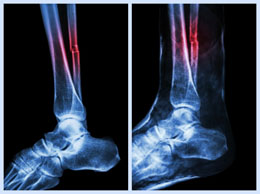Fibula pain is pain in the lower leg, or to be precise, in the calf bone. This article provides brief information regarding this pain.

Those who have been involved in sports like soccer, baseball, hockey, or any other contact sport are not surprised by a shin bone or a knee injury. Day in and day out players injure their knees, hamstrings, calves, or shin bones. Fibula or calf bone injuries and consequent pain too are routine for athletes if not so common as the others. Fibula pain is primarily experienced as a result of a break in the fibula, which connects closely with the shin bone.
Fibula Bone
Among the two bones which comprise the lower leg, fibula is smaller, the other one being the tibia or the shin bone. The head of the fibula is very close to the knee joint and if a cross section is taken, this bone appears triangular. It creates a joint with the shin bone near the ankle and knee. This bone has a major role to play in muscle attachments and formation of joints, especially knee.
Pain in the Fibula Bone
There are a number of causes of fibula bone pain. Some of the most common causes are calf strain, osteoma, osteomyelitis, varicose veins, injury, and fibula bone fracture. The calf pain is typically accompanied by bruising, slight swelling, overall discomfort, and probably difficulty in walking.
Fracture and Pain
The pain may occur as a result of a strain or a fibula fracture. Following is a brief overview of the causes, symptoms, and treatment of the fibula fracture are described below:
Causes and Symptoms
When there is a break in the fibula, it leads to fracture of the calf bone. The fracture can be a result of a rolled ankle, especially with considerable weight bearing forces. In other cases, an awkward landing after a jump on uneven surfaces, a fall, or a straight impacting injury to the outer part of the leg or ankle can lead to a fibula stress fracture. As is the case with any kind of fracture, there is an intense pain in the lower leg and an inability to bear weight, along with ankle pain. Swelling and bruising follow almost immediately along with pain.
Treatment
To alleviate the pain and to get the calf bone back on track, doctors normally do an anatomical reduction of the bone through a fibula fracture surgery. This means that realignment of the fracture is done by manipulating it carefully. Moreover, internal fixations for stabilizing the fracture and lessening the pain are done with the help of plates and screws. If the pain is caused by just the break and not a displacement, usage of braces or protective boot is advised. During the time of recovery, the doctors usually advise avoiding activities, like running which will exert pressure and put weight on the bone since that can lead to pain while running.
Eventually, depending on the underlying causes of pain, it can take anywhere from a few days to months for a person to heal completely. Physiotherapy and exercises for strengthening the fibula are suggested by doctors in case of fractures. If there is no fracture, resting the calf bone, giving it a slight massage, and applying heat pack may help reduce the pain.
Disclaimer:
This Buzzle article is for informative purposes only, and should not be used as a replacement for expert medical advice.


 Those who have been involved in sports like soccer, baseball, hockey, or any other contact sport are not surprised by a shin bone or a knee injury. Day in and day out players injure their knees, hamstrings, calves, or shin bones. Fibula or calf bone injuries and consequent pain too are routine for athletes if not so common as the others. Fibula pain is primarily experienced as a result of a break in the fibula, which connects closely with the shin bone.
Those who have been involved in sports like soccer, baseball, hockey, or any other contact sport are not surprised by a shin bone or a knee injury. Day in and day out players injure their knees, hamstrings, calves, or shin bones. Fibula or calf bone injuries and consequent pain too are routine for athletes if not so common as the others. Fibula pain is primarily experienced as a result of a break in the fibula, which connects closely with the shin bone.